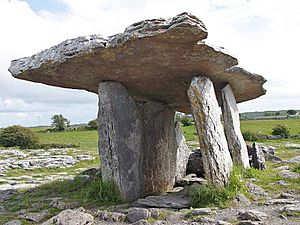Dolmen facts for kids
A dolmen is a type of single-chamber megalithic tomb. It usually consists of three or more upright stones (megaliths) supporting a large flat horizontal capstone (table).
Most date from the early Neolithic period (4000 BC to 3000 BC). Dolmens were usually covered with earth or smaller stones to form a barrow, though in many cases that covering has weathered away, leaving only the stone "skeleton" of the burial mound intact.
It remains unclear when, why, and by whom the earliest dolmens were made. The oldest known dolmens are in Western Europe, where they were set in place around 7,000 years ago. Archaeologists still do not know who erected these dolmens, which makes it difficult to know why they did it. They are generally all regarded as tombs or burial chambers, despite the absence of clear evidence for this. Human remains, sometimes accompanied by artefacts, have been found in or close to the dolmens which could be scientifically dated using radiocarbon dating. However, it has been impossible to prove that these remains date from the time when the stones were originally set in place.
Images for kids
-
Dolmens in Amadalavalasa, Andhra Pradesh, India
-
Dolmen at Ganghwa Island, South Korea
-
Trethevy Quoit - one of the best-preserved in Cornwall, UK dated to around 3500–2500 BCE
-
Chûn Quoit in Cornwall, UK, about 2400 BCE
-
Zennor Quoit in Cornwall, UK, 2500–1500 BCE
-
Lanyon Quoit in Cornwall, UK, 3500-2500 BCE
-
A dolmen erected by Neolithic people in Marayur, Kerala, India.
-
A southern-style dolmen at Ganghwa Island, South Korea
-
The biggest dolmen near Hwasun, South Korea
-
Kilclooney More dolmen near Ardara, County Donegal, Ireland
-
T-shaped Hunebed D27 in Borger-Odoorn, Netherlands
-
Dolmen of Bisceglie, Apulia
-
Tinkinswood, Vale of Glamorgan, Wales, around 3000 BCE
-
Dolmen of Oleiros, Galicia
-
Musealised Dolmen de Dombate, Galicia (Spain)
See also
 In Spanish: Dolmen para niños
In Spanish: Dolmen para niños





























